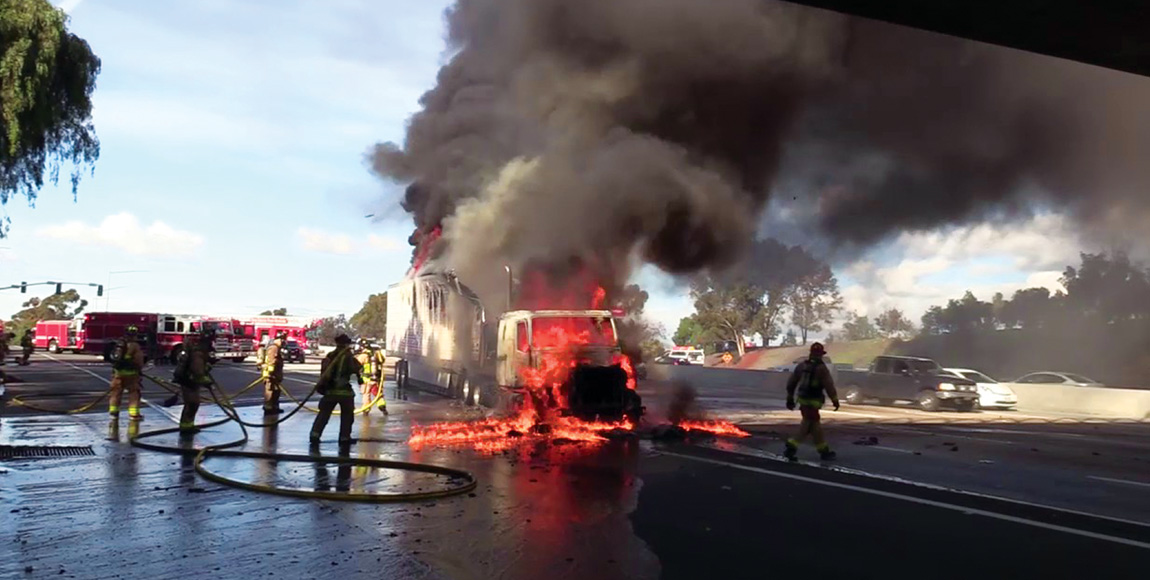Redefining vehicle fires

With higher levels of electrification being installed into modern vehicles, and with the increased use of alternative powerplants, fighting a vehicle fire needs to be handled with extra care.
Randolph J. Harris, a certified vehicle fire investigator with over 500 vehicle-fire investigations to his name, has found that the most common cause of truck fires is an electrical short in the engine compartment.
“An electrical short occurs at over 2 760°C (hot enough to melt iron). This overheating can ignite the insulation and any nearby combustibles. The shorted wire (typically unfused) can overheat completely back to the batteries, cause additional arcing, and ignite any combustibles along its path, including diesel hoses. However, a fire from another source can damage these wires and cause them to arc,” he explains.
Interestingly, Harris has found that arson contributed to 20 percent of the fires he has investigated (the second most common cause); with trailer fires caused by overheating brakes, bearings or flat tyres the fourth most common; accidents the fifth most; fluid leaks the seventh most and human carelessness the ninth most common.
Michael P. Daley, an instructor with the Middlesex County Fire Academy, comments on Firehouse.com that vehicle fires pose considerable safety risks to responding units and firefighters, and that commercial-vehicle fires compound these risks significantly.
“Fuel loads, flammable and hazardous material exposure, coupled with limitations in accessibility and resource deployment can make these incidents very perilous,” he states.
As vehicles running on battery power, hybrid systems or alternative fuels, such as natural gas or (to a lesser extent) hydrogen, begin to enter the market, these risks and hazards are compounded. Very often, dealing with these types of vehicle fires requires firefighters to ignore years of training.
Steve Smith, retired lieutenant with Arvada Fire Department in Colorado, writes for Fire Engineering
magazine: “Commercial compressed-natural-gas vehicles are very safe and significantly reduce emissions and pollution. When they are on fire, however, special precautions and altered firefighting techniques must be used for everyone’s safety. As firefighters, we are trained to put the water on the fire, but we cannot in these situations. Knowing how to identify these vehicles is the first step in protecting oneself and the public.”
Swedish vehicle fire suppression specialist, Dafo, is one company participating in a new research project on electric- and hybrid-vehicle fire risks. The company adds that, while a growing number of electric and hybrid vehicles are taking to the roads, knowledge on the risks associated with these vehicles is limited.
It is therefore contributing to a new research project funded by Sweden’s innovation agency, Vinnova, where risks posed by lithium-ion (li-ion) vehicle batteries will be addressed and investigated on how they should be managed.
“With this new project we will map the fire risks associated with li-ion batteries and mitigating the consequences of fires in electric and hybrid vehicles. The big increase in electric vehicles and the transition to renewable fuels means that this is a very important and exciting project,” says Johan Balstad, business area manager, Dafo Vehicle Fire Protection AB.
Balstad continues: “Fire risks related to battery spaces, including procedures for handling electric vehicles and batteries after a crash, bearing in mind the risk of fire at a later stage, will be studied. This work will lead to future safety solutions, including system design and battery placement.
“The focus of this project will be to investigate the extent to which fixed and/or integrated fire-suppression systems, that are widely used to protect engine compartments on heavy vehicles, can be applied to vehicles powered by li-ion batteries, as well as how the systems should be designed.”
Interestingly, 94 percent of all public-transport buses in Sweden already have fixed fire-suppression systems installed.
Published by
Focus on Transport
One Comment
Leave a comment Cancel reply
focusmagsa





“…the most common cause of truck fires is an electrical short in the engine compartment.”
“…94 percent of all public-transport buses in Sweden already have fixed fire-suppression systems installed.”
Good information. I’m guessing most or all of the fixed fire suppression systems are in the engine compartment. Do these systems, when a fire is detected, automatically shut-off the electrical supply energizing the short? If not, how can they be effective against the most common type of fire?